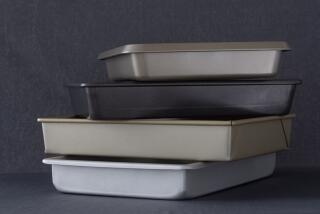Cure for Cookie Stick-to-Itiveness
- Share via
Question: I have access to a great many egg whites; therefore, I often make macaroons or haystacks. No matter what I use--non-stick pans, heavily greased pans, wax paper--or all three, I don’t seem to be able to keep these cookies from sticking to the pan. Can you help me?
Answer: Line the baking sheets with parchment paper and your problem should be solved. The paper is available at some groceries, as well as at cooking specialty stores.
Q: Whatever happened to Whitney’s yogurt? Their lemon flavor was may favorite. Is it gone forever?
A: We can’t say that it’s gone forever, but the company that formerly distributed the product in this area tells us it is no longer available in California.
Q: I bought some self-rising flour by mistake and now I don’t know how to use it. Please help.
A: Each cup of self-rising flour contains 1 1/2 teaspoons baking powder and one-half teaspoon salt. It may take a little arithmetic, but using these figures you should be able to use the self-rising flour in most recipes. Since self-rising flour is made from soft wheat, while all-purpose flour is a mixture of soft and hard wheat, some differences will result in the end products, especially in biscuits and cakes.
Q: Your article on peppercorns missed one. We were given a jar of pink peppercorns and I can find no reference to them in any of my numerous cookbooks. I would appreciate any information on same.
A: We didn’t cover pink peppercorns because they are not actually peppercorns, but the berries of a tree species that grows on Reunion Island in the Indian Ocean. Their botanical name is schinus terebinthifolius. A number of French companies harvest the berries and pack them in brine, in vinegar or freeze-dried.
In 1981, Times staff writer Dan Puzo reported that several university botanists claimed pink peppercorns were mislabeled and were a potentially toxic substance. The U.S. Food and Drug Administration placed an import alert on the product, but dropped it in 1983 in light of results from a French research study and long-term usage of the product in that country.
Pink peppercorns gained popularity in the early 1980’s, both in chic restaurants and gourmet shops as a prestige spice in nouvelle cuisine. They are used to give color and flavor to sauces for meat and seafood.
More to Read
Eat your way across L.A.
Get our weekly Tasting Notes newsletter for reviews, news and more.
You may occasionally receive promotional content from the Los Angeles Times.










